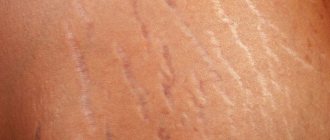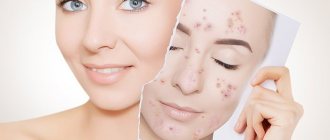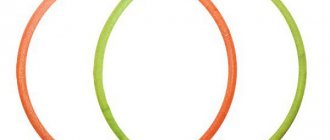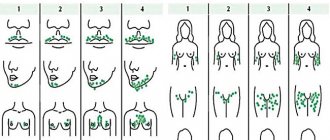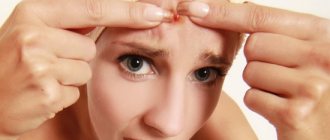What are the types of acne marks?
Those who like to squeeze out pimples and blackheads can be immediately noticed by their characteristic skin defects.
Atrophic scars are small, depressed scars with smooth edges. Most often they appear on the face and come in several types:
- Rectangular . Oblong-shaped recesses, which experts call “freight trailers.” The deeper such scars, the more difficult it is to remove them.
- Chipped . Elongated “cut” oblong paths. Most often they occur on the cheeks and are very difficult to correct, since even with a small size they can have a decent depth.
- Rounded . The pits are round in shape, which can be superficial or deep. If small lesions can be dealt with using light peeling and home remedies, then deep ones have to be removed using laser procedures and deep chemical peeling - exfoliation of the upper layers of the skin.
Hypertrophied scars are raised above the surface. They most often form on the back and chest. They often occur in patients with a tendency to keloid processes - a feature of the body in which any damage is accompanied by extensive growth of connective tissue. As a result, unsightly bumps appear at the site of acne, often having a reddish or bluish tint.
Post-inflammatory erythema is red marks left at the site of acne. They may disappear over time, but without treatment they will persist for 6-12 months or longer.
Post-inflammatory hyperpigmentation is dark spots left behind by acne. They can have different shades from light to dark brown. They intensify after exposure to the sun, so if you are prone to their formation, you should use sunscreen during the hot season.
After severe acne, several types of such marks may appear on the skin at once, especially if you do not consult a cosmetologist in time and take action.
Atrophic scars
Keloid scar
How to remove acne marks: important points
Before moving directly to ways to get rid of acne marks on the face, you need to clarify a few interesting things.
What can you do to increase the effectiveness of home and salon treatments?
As with everything, the result depends on the initial data, the expected results also play an important role. The larger the gap between the first and second, the more difficult it is to achieve the desired effect. You can help the skin regenerate and return to normal by feeding it the nutrients necessary for the formation of new cells:
- Take a course of pharmacy vitamins and minerals;
- More fatty acids: Omega 3/6/9. They are useful for the body in any condition; it is useful to drink them periodically in a course;
- Inject a cocktail of hyaluronic acid and vitamins. This will retain water in the cells and hydrate the skin.
What else can you do to help your body remove traces of acne:
- Quit bad habits. The skin of smokers takes longer and is more difficult to heal, which contradicts the principles of post-acne treatment. It is better to avoid alcohol completely a few days before a cosmetic procedure and abstain for the same amount of time after it;
- Understand that modern cosmetology is not magic yet and cannot cure everything. Alas, today no miracle procedure has yet been invented that will eradicate the problem forever in one go;
- Be mentally prepared for long-term treatment, do not rush things and do not lose heart. The problem will be solved, just not right away;
- Avoid tinted decorative cosmetics. Foundations of all stripes, powder, contouring and others will not hide post-acne properly and will not cure it. But they can greatly aggravate the situation and slow down the treatment process.
Why do acne marks form?
The development of these skin manifestations is influenced by many factors, one of which is genetic. Some patients are so prone to acne scarring that they develop marks from even mild acne. Often this trait happens in families. This category of patients needs to especially carefully monitor their skin condition.
In other cases, it is impossible to predict whether the patient will have acne marks. Therefore, it is important that all skin manifestations are promptly treated by a dermatologist. Early treatment will help clear up pimples before they damage your skin.
Post-acne: treatment of spots and scars after acne
- 1. Successful acne treatment
- 2. Acne in teenagers
- 3. Acne in adults
- 4. Treatment of acne
- 5. Post-acne: treatment of spots and scars
- 6. Types of acne
- 7. Causes of acne
- 8. Hardware techniques in the treatment of acne
- 9. Retinoids, retinoid treatment
- 10. Acne and homeopathy
- 11. PDT HELEO4 for acne
Treatment of acne and post-acne is the main specialization of our Center. Treatment of skin for acne and acne is a multi-stage process that must be carried out under the supervision of a dermatocosmetologist. Since 1993, we have been successfully helping patients with acne, and especially with severe forms of acne, such as acne conglobata. Treatment of acne and post-acne in our Center is aimed not only at reducing external manifestations through cosmetic procedures and home programs, but also at identifying the internal causes of the disease and their correction, as well as improving the overall condition of the skin in general. The center deals not only with the treatment of emerging acne, the treatment of post-acne scars, acne scars, the removal of acne spots, and acne marks. Modern achievements of medical science and the unique long-term medical experience of our doctors ensure highly effective treatment of acne and pimples.
Post-acne: spots after acne, marks after acne, scars after acne
Acne spots, marks, scars - this is what sometimes remains after the main symptoms of acne have been eliminated. But there is no need to despair. There is always a way out. In the treatment of acne scars, cosmetologists at the Danae Center use effective programs to restore the skin. Proven and reliable methods, acting on the skin, normalize sebum secretion, reduce pores on the skin of the face, restore a healthy complexion, make the skin smooth and beautiful, and also help prevent the recurrence (recurrence) of acne and acne.
Acne marks: causes
The vast majority of acne scars that we work with appear as a result of independent attempts to squeeze out a pimple that has appeared. Often our doctors hear complaints of itching in the area of the healing element, which forces patients to scratch the skin or pick off scabs. Constant injury does not allow the skin to heal properly, the inflammatory process drags on and spreads further. As a result, we see uneven skin with acne scarring and pimple marks. Another reason is the improper treatment of severe papulopustular, nodular and conglobate acne without promptly prescribing protuberculous therapy, managing such patients without isotritinoins, and performing surgical incisions. But even for such patients, we help to significantly improve the condition of the skin, and sometimes remove acne marks completely.
Acne scars:
- Atrophic acne scars: pitting of the skin is the most common change in the skin after acne
- Hypertrophic acne scars: bumps on the skin
- Keloid scars are smooth, firm, purple or red formations.
Photo: Post-acne atrophic scars on the temples
Photo: Post-acne atrophic scars on the cheek
How to get rid of acne spots: treatment methods in our Center
In our Center, a whole range of activities is aimed at restoring skin after acne. Skin rehabilitation programs include various types of mesotherapy, special medical peelings, laser peeling, oxygen-ozone injections, phototherapy, etc. The choice of procedures depends on the type of post-acne (pigment spots, scars, uneven skin), on the age of the problem (fresh scar, several years ) and on the general condition of the body.
Laser peeling
Laser peeling (fractional photothermolysis) is the leading procedure for removing post-acne scars. High efficiency is achieved, among other things, through proper preparation of the skin for the fractional photothermolysis procedure and the appointment of recovery programs after it. The peculiarity of our device is its short rehabilitation period (up to 3-4 days) with minimal changes on the skin (slight peeling and redness). After treatment, the rough scar tissue is removed, and young healthy tissue is formed in its place. Acne spots and marks are removed, the skin becomes smooth and even. The effect is noticeable after the first procedure.
RF therapy
RF therapy is recognized in world practice as one of the best methods for post-acne scars and their treatment. This is a radiofrequency effect on connective tissue cells in order to improve the synthesis of collagen and elastin, which provide elasticity and strength to the skin. After a course of procedures, the scar tissue seems to shrink and is replaced by new collagen fibers. RF therapy, unlike laser treatment, can be carried out all year round.
Phototherapy using the M22 device
After the removal of acute inflammation, bluish, red spots and post-inflammatory pigmentation often remain. With M-22 we can significantly reduce the time it takes to restore an even skin color. After just one procedure, the spots become significantly lighter.
Oxygen-ozone therapy, oxygen mesotherapy
This method is effective for atrophic scars (pits in the skin). It can be used on both fresh and old scars. It is also one of the few methods that reduces relatively old hypertrophic scars (not keloids). Oxygen enhances microcirculation in the skin, helps soften connective tissue formations in the scar area, and has an anti-inflammatory and healing effect. Read more…
Biorevitalization with hyaluronic acid for post-acne
The indication for biorevitalization is fresh scars. The scars should be so young that there is still redness after acne, but there are no papules and pustules. In recent years, it has become known that propionobacteria (acne bacteria) secrete an enzyme - hyaluronate lyase, which stimulates the destruction of its own hyaluronic acid in human skin. An unfavorable background is created for its successful regeneration. Therefore, mesotherapy with hyaluronic acid is an important factor in smoothing acne scars.
Homeopathic treatment
Our rehabilitation programs also include homeopathic anti-scar medications, which we prescribe both as mesotherapy for scars and for oral administration. Homeopathic medicines have anti-inflammatory, antiexudative, antitoxic, regenerating effects, improve microcirculation, stimulate the immune system, and activate wound healing. They are good tools for both treatment and prevention of the formation of new scars. Read more...
Mesotherapy
Mesotherapy for the treatment and restoration of skin after acne, depending on the formulation used, solves various problems: eliminating acne spots, smoothing.
Peelings
Peels activate microcirculation and general metabolic processes in the skin, have a vascular strengthening, absorbable and, if necessary, whitening effect. Stimulation of collagen formation in the skin during its restoration after peeling leads to a decrease in the depth of scars, they become invisible against the background of the surrounding skin.
Face and back cleansing
Cleaning removes comedones, shrinks cleaned pores, normalizes sebum secretion, smoothes porous skin, improves microcirculation, evens out skin texture and skin color.
Face and back massage
The purpose of massage to reduce scars, spots and acne marks on the face and back is to combat metabolic disorders at the cellular level caused by the accumulation of toxins in the intervening tissues, removing toxins, improving the quality of dermal tissues. With the help of massage, skin turgor and complexion improve, blemishes go away.
Similar approaches to treating skin from blemishes, scars and acne marks are also effective for rejuvenation, prevention of wrinkles and early skin aging, as the skin is strengthened and tightened. Therefore, when treating so-called late acne (at 25-40 years), patients, along with cleansing, gain smooth and elastic skin.
These and other cosmetological techniques in combination with a dermatological approach give good therapeutic results in the treatment of post-acne in our Center.
Benefits of removing acne marks and spots, acne scars in our Center
Since 1993, our Center has specialized in acne and post-acne, skin treatment and restoration. Removing acne scars and acne marks is one of the priorities of our Center. Extensive experience in this area allows us to achieve high efficiency in the treatment of patients with post-acne. We have collected almost all the hardware and therapeutic techniques available in modern cosmetology for the treatment of post-acne, and also have our own developments. It is very important for us that the treatment methods used are safe and have the necessary permits.
Acne with proper treatment is a temporary phenomenon, and the habit of regularly taking care of your skin will allow you to keep it clean, fresh and beautiful for many years.
Come to our Clinic, we will help you not only cure acne, but also reduce its effects on the skin.
How to remove acne marks
Inflammatory erythema, the red marks left by acne, is treated with creams and serums containing anti-inflammatory ingredients. Therapeutic masks that soothe the skin have a good effect. It is undesirable to be in the sun without sunscreen, since hyperpigmentation in the form of dark areas may appear in place of the red spots.
Hyperpigmentation - dark marks are removed using whitening masks or creams. If there is no effect, they resort to prescription drugs - hydroquinone, azeleic acid and tazarotene, which improve the appearance of the skin. The laser gives a good effect. Two to three procedures are usually sufficient to significantly lighten age spots.
Atrophic acne scars, which appear as depressions or pits in the skin, usually do not go away without treatment. In this case, carbon dioxide and erbium lasers will help, which stimulate the production of collagen, the protein that fills such traces. The effect of microneedles helps, breaking up scars and stimulating the restoration of skin structures.
Hypertrophic scars also do not disappear over time. To eliminate them, laser and mechanical resurfacing – dermabrasion – is prescribed. Peels help well - procedures during which the top layer of skin along with scars is removed with the help of chemicals. Such treatment can be combined with the prescription of absorbable drugs.
Removing acne marks
What are acne spots?
Before getting rid of dark spots on the skin, it is necessary to take into account the characteristics of their appearance. There are 3 main types of hyperpigmentation.
These are sun spots or sun damage that appear due to increased melanin production. The most striking example of sunspots is the familiar freckles.
The second type is melasma, which develops due to changes in hormone levels. And the last type is post-inflammatory hyperpigmentation.
It develops after injury to the skin with developing inflammation. It is this type that includes acne spots, namely the appearance of pink, red or dark brown spots.
That is, essentially acne spots are hyperpigmentation. This means that they need to be dealt with using methods that stop the excess production of melanin.
Read on to learn how to treat this type of hyperpigmentation with over-the-counter medications, prescription creams, and more.
When to start treating acne scars
Treatment should begin at the stage when the acne begins to disappear - there is no need to wait until the skin is completely clear. In this case, it may be possible to completely avoid the appearance of residual marks. Ideally, you should contact a cosmetologist immediately after acne forms. A specialist will help get rid of acne, preventing it from spreading across the skin.
The ideal option is to prevent acne. In spring and summer, when there is increased sebum production and the skin is exposed to dust and other negative factors, you need to undergo preventive treatment. For this purpose, facial cleansing is carried out, during which conditions are created that prevent the formation of acne.
To get rid of acne and the marks caused by it, you need to contact the Center for Aesthetic Medicine. Specialists will select the most suitable treatment method and improve the appearance of the skin.
Which is best for each skin color?
Skin tone plays a role in the intensity and duration of treatments for treating hyperpigmentation. Dermatologists note that people with light, medium, and dark skin tones can use the same treatments. But people with darker skin take longer to see noticeable results.
With proper treatment, acne spots lighten and usually disappear within a couple of weeks to 3 months. But everything, of course, depends on the chosen treatment method and the depth of the spot. In any case, patience is the key to any treatment option.
Fair skin responds well to most treatments for hyperpigmentation.
If you sunbathe or have dark skin, the following procedures are prohibited:
- Lasers;
- IPL therapy.
For medium skin tones, the following options are considered very effective:
- chemical peeling;
- microdermabrasion.
On darker skin it is possible to use:
- glycolic acid;
- kojic acid;
- lightening creams;
- microdermabrasion;
- home chemical peels;
- laser treatment, but only when used at a lower intensity and with a larger number of sessions.
Lightening creams are over-the-counter products that contain certain ingredients that lighten pigmentation. Many of these creams are available in strong prescription forms. They are usually applied once or twice a day. After a few weeks, the brightening effect is already noticeable. Lightening products also come in gel form.
Common ingredients found in lightening cream and gel lines include:
- hydroquinone;
- licorice extract;
- N-acetylglucosamine;
- arbutin;
- vitamin B-3 (niacinamide);
- vitamin C;
- bearberry extract;
- kojic acid.
Lightening creams or gels are better at lightening flat spots, such as melasma or post-inflammatory hyperpigmentation (spots from acne, chicken pox and other diseases). They are great for brightening any skin type.
Post-acne removal with laser
Laser treatment is actively used to combat scars and other manifestations of post-acne. It can be used for general resurfacing or as fractional radiation.
The continuous laser resurfacing method involves uniform vaporization of the surface layers of the epidermis. Under the influence of a laser, the regeneration process starts in the skin tissues. As a result, fresh, smooth skin is formed at the site of resurfacing.
Laser resurfacing has one drawback - the risk of complications in the form of hyperpigmentation. But if the procedure is performed by an experienced cosmetologist, then there is no reason to worry. An important advantage of resurfacing is that the desired cosmetic effect can be achieved in just 1 session.
An alternative method of laser treatment for post-acne is fractional exposure. During this procedure, a laser beam hits the skin with microscopic beams. They selectively damage individual skin cells, which triggers natural regeneration. To improve the condition of the skin, 3-4 procedures will be required (depending on the area and depth of post-acne). Sessions should be held at intervals of 4-5 weeks. Fractional exposure is less traumatic than laser resurfacing.
The benefits of laser treatment for post-acne include:
- pronounced cosmetic effect;
- the laser has an antiseptic effect on the skin, this improves local immunity and reduces the risk of infection of the treated area;
- additional lifting effect, in addition to eliminating post-acne, the laser removes signs of age-related changes, fine wrinkles and sagging skin;
- minimal rehabilitation period; the skin returns to normal within a period of several hours to 7 days.
A modern laser installation with an erbium laser MCL-30 Dermablate manufactured by Asclepion Laser Technologies (Germany), installed in our Clinic, allows you to precisely regulate the intensity and depth of the effect on the skin. That is why this device is considered not only the most effective in the fight against post-acne, but also absolutely safe for human health.

